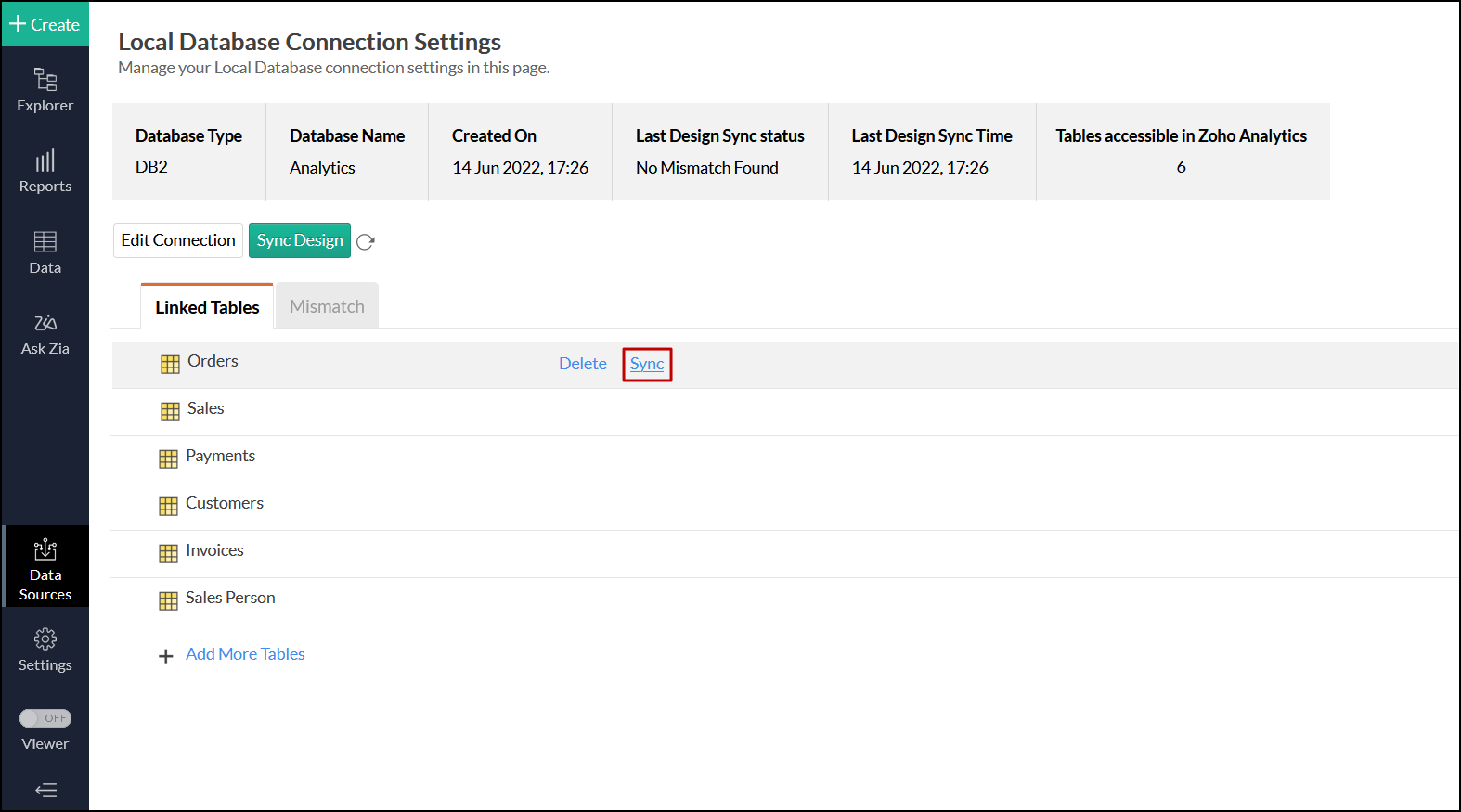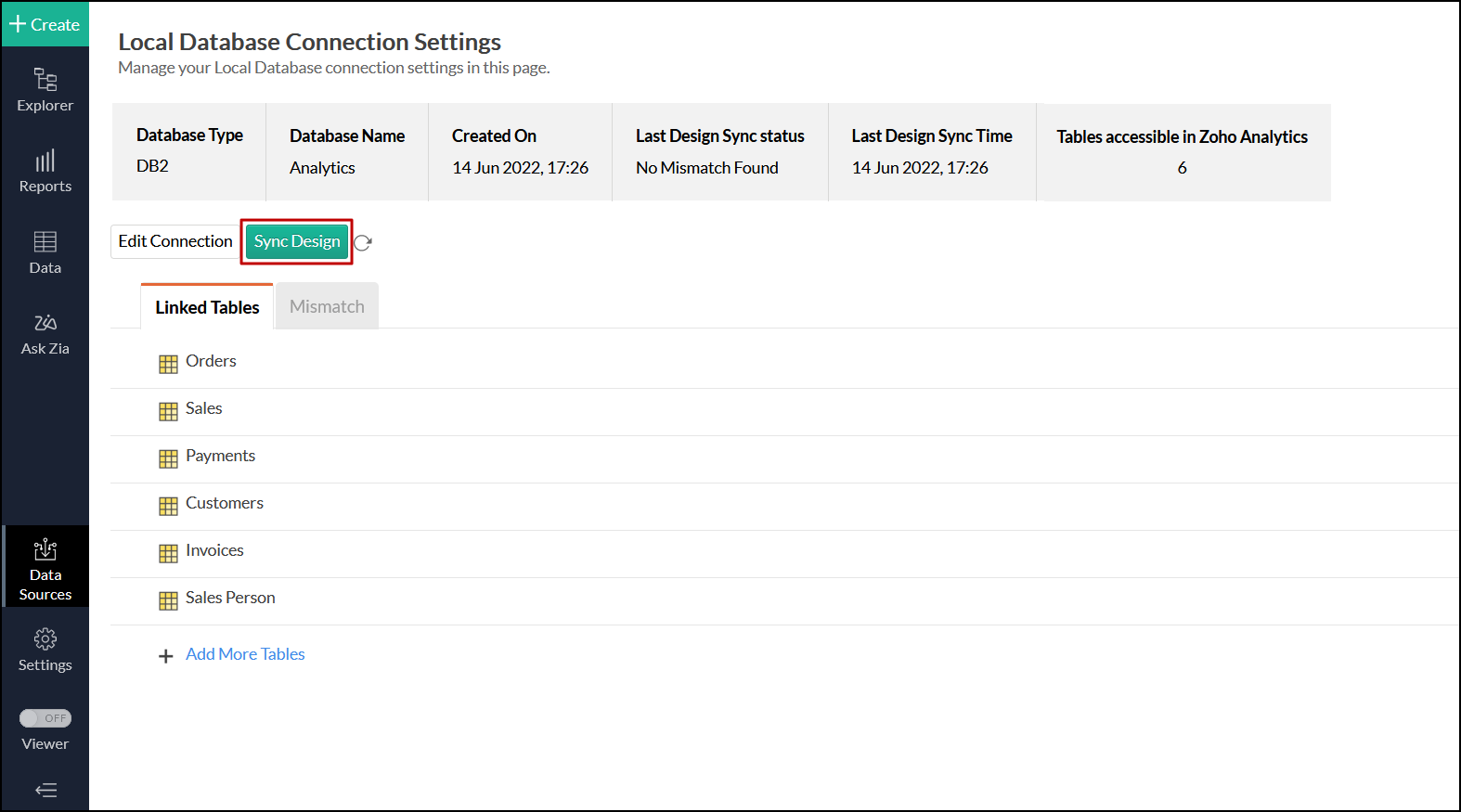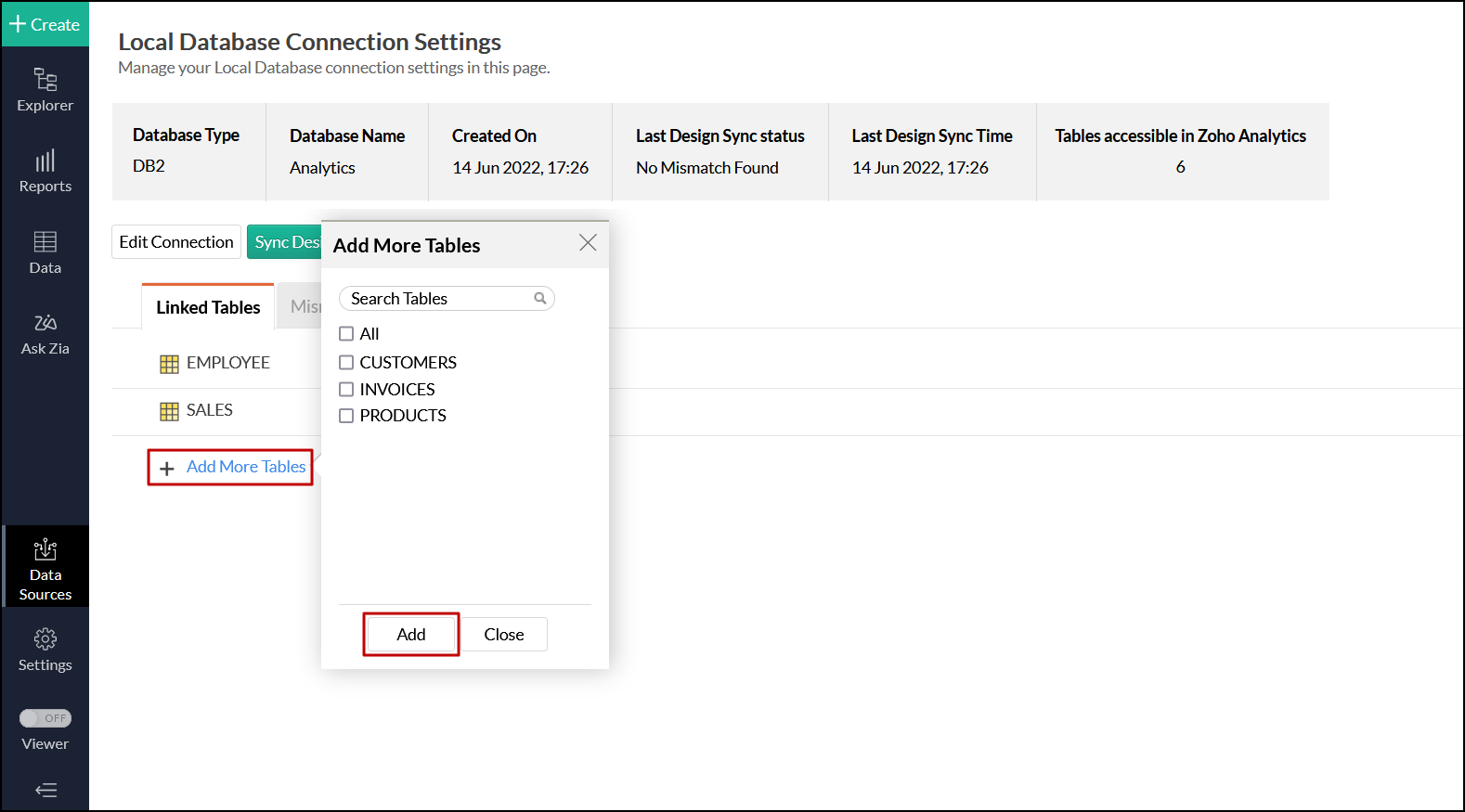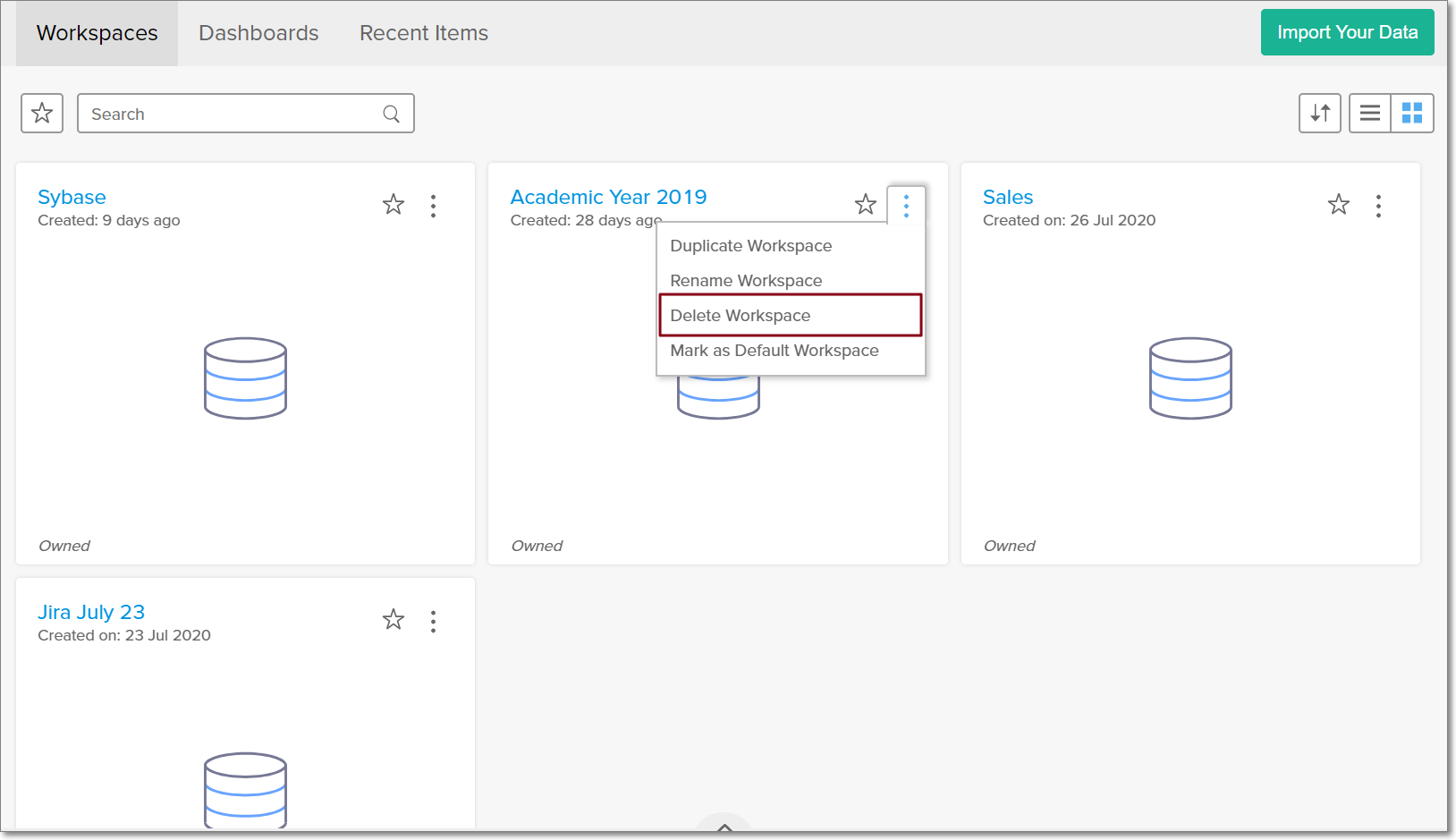Import data from DB2
-
Data Import: Data from your database will be imported and stored in Zoho Analytics. Periodic schedules can be set up to fetch the latest data automatically from the local database.
-
Live Connect: In this mode, data will not be imported and stored in Zoho Analytics. Instead, Zoho Analytics will display live data from your database when reports and dashboards are launched. The report loading time will directly depend on the response and performance of DB2. Live connections offer the convenience of real-time updates.
Data Import
1. How do I import data from the DB2 local database?
2. How can I edit the setup?
You can edit the import setup anytime needed by following the steps below.
- Open the Workspace.
- Click Data Source from the left bar.
- All data sources for this Workspace will be listed. Click the DB2 data source you want to edit.
- The Data Source page will open. Modify the settings as needed.
3. How long does it take for the data to be imported into Zoho Analytics?
After setup, you might have to wait sometime for the initial fetch to happen. This depends upon the amount of data to be imported into Zoho Analytics and also the response time of your local database. You will receive an email notification once the import is complete. Please note that if you access the workspace before the initial fetch, it will not display any data.
4. How can I schedule import from DB2?
Zoho Analytics allows you to schedule the import anytime. You can schedule the import for an existing table by following the steps below.
- Open the workspace.
- Click Data Source from the side panel.
- All data sources for this workspace will be listed. Click the required DB2 data source.
- The Data Source page will open. Click the Sync Settings button.
- The Local Database - Synchronization Settings will open.
- Select the schedule interval you need in the Repeat drop-down. Supported intervals are:
- Not Scheduled
- Every 'N' Hours
- Every Day
- Weekly Once
- Monthly Once
- Select when the data need to be imported in Perform option.
- In the Notify me after every 'N' Import Failure (s) option, set the number of consecutive import failure after which you need to be notified.
- Click Save. The data for your DB2 will be imported into Zoho Analytics in the set interval.
You can also schedule the import during initial import setup, using the Schedule Setting option in the Step 4 of Import Wizard.
5. Will I be notified on import failures?
Yes, you will be notified after consecutive import failure, in case it occurs. You can set the number of consecutive import failures after which you need to be notified in the Notify me after every 'N' Import Failure (s) option of the schedule import.
6. Will foreign keys defined between my tables in the DB2 be linked in Zoho Analytics as well?
When importing multiple tables, the foreign keys defined between the tables in DB2 will be linked in Zoho Analytics. The foreign keys will be created as Look-up columns in Zoho Analytics.
If you import data from one table at a time (using the single table option) then the foreign keys will not be defined. However, you can manually link the tables in Zoho Analytics using the Look-up column feature. Click here to learn about the Look-up column feature.
7. Can I change the data type of the columns imported in Zoho Analytics?
Yes, you can change the data type of the columns imported into Zoho Analytics. However it is necessary that the data type of your column is compatible with the data type of the column in your DB2 for successful data synchronizations. It is always recommended that you change the data type in both your DB2 as well as your Zoho Analytics workspace.
8. I have synced data from a database into a table. Can I change the data source of this table?
Yes, you can change the data source of the table into which the DB2 has been synced.
Follow the below steps to import if the source is available in the same DB2 that is imported into the table.
- Open the workspace. Select the Import Data option from the side panel and click Import into this Table.
- The Select Data to Import tab of the Import wizard will open.
- You can choose to import from a different table using the Select Table option or import using the Custom Query option.
Follow the below steps to import data if the source is available in a different local database.
- Open the workspace and select the Data Source option from the side panel.
- All data sources for this workspace will be listed. Select the data source you wish to edit, and click Edit connection in the page that appears.
- In the Local Database - Edit Connection dialog that opens, modify the data source.
9. Can I import data from DB2 into an existing Zoho Analytics workspace?
Yes. Follow the below steps to import data into an existing workspace:
- Open the workspace into which you wish to import the data.
- Navigate through Create > New Table / Import Data.
- Click the Local Databases option.
Configuring the import will be similar to the steps followed in this presentation.
10. How do I remove the Setup?
To remove the setup,
- Open the required workspace and click Data Source tab from the side panel. The Data Source page will open.
- Click the Settings icon.
- Select Remove Data Source from the drop-down menu that opens.
Please note that the data source connection will be removed, but the tables and the data will be retained in the workspace. As the data source connected is removed, no further synchronization will happen.
Live connect
1. How do I connect live with the DB2 database?
2. How do I edit the live connection configuration?
3. What are the differences between data imports and live connections?
|
Data Import |
Live Connect |
|
The data from the DB2 database will be imported and stored in Zoho Analytics.
|
The data from the DB2 database will be fetched live whenever you create or access a report in Zoho Analytics. |
|
Data from other sources can be imported into the same workspace and combined for reporting and advanced analysis.
|
Data from other sources cannot be imported into a workspace that is created using live connections.
|
|
Changes made to the columns in the data source, such as addition or deletion, will be synchronized automatically.
|
To reflect any changes in data structures from the data source to Zoho Analytics, manual synchronization has to be carried out.
|
|
Query tables can be created.
|
Query tables cannot be created in a workspace set up with live connect.
|
|
Report loading time will be fast, as the data is stored locally in Zoho Analytics.
|
As data from the source database is not stored locally in Zoho Analytics, the loading time will depend on the performance of database, and the amount of data included in the report.
|
4. How long does it take to visualize data in Zoho Analytics?
5. Will the foreign keys defined between tables in the database be defined in Zoho Analytics?
6. Why am I unable to access a table or a report in Zoho Analytics?
7. What is a Mismatch?
8. When do Mismatches occur and how do I resolve them?
9. How to reflect the meta data changes of individual tables from the local database instantly?
-
Open the required workspace, and click the Data Sources tab from the side panel.
-
Navigate to the required data source, and click the Sync option that appears on mouse over the required table name.

-
The meta data changes of the selected table will be reflected instantly from the local database to the Zoho Analytics table.

10. Is it possible to connect live with newly added tables in the DB2 database?

11. Is it possible to change the data type of the columns in Zoho Analytics?
12. Can I import data from other data sources into a workspace set up with live connection?
13. Can I create query tables in workspaces set up with live connection?
14. What happens when I delete or rename the database in DB2?

15. How do I remove the DB2 setup?

Zoho CRM Training Programs
Learn how to use the best tools for sales force automation and better customer engagement from Zoho's implementation specialists.
Zoho DataPrep Personalized Demo
If you'd like a personalized walk-through of our data preparation tool, please request a demo and we'll be happy to show you how to get the best out of Zoho DataPrep.
You are currently viewing the help pages of Qntrl’s earlier version. Click here to view our latest version—Qntrl 3.0's help articles.
Zoho Sheet Resources
Zoho Forms Resources
Zoho Sign Resources
Zoho TeamInbox Resources
Related Articles
Import data from Amazon RDS Maria DB
If you have your data stored online in the Amazon RDS - Maria DB database, then you can easily import your data into Zoho Analytics for reporting and analysis. You can also easily set up schedules to periodically fetch the latest data from your Maria ...Import data from Microsoft Azure Maria DB
If you have your data stored in Microsoft Azure Maria DB Cloud Database, then you can easily import your data into Zoho Analytics for reporting & analysis. You can also set up schedules to fetch the latest data from your Microsoft Azure Maria DB ...Import data from Rackspace Cloud Maria DB
If you have your data stored in Rackspace Cloud Maria DB, you can easily import the data into Zoho Analytics or connect live with the Rackspace Cloud Maria DB server for advanced reporting and analysis. Data Import: Data from your cloud database ...Import data from Microsoft Azure
If you have stored your data stored in PostgreSQL, Maria DB, SQL Database, or SQL Data Warehouse database hosted in Microsoft Azure, then you can easily import the data into Zoho Analytics. You can easily setup data import from the Microsoft Azure ...Import data from Amazon RDS
If you have stored your data stored in MySQL, SQL Server, Oracle, Amazon Aurora, PostgreSQL or Maria DB database hosted in Amazon RDS, then you can easily import the data into Zoho Analytics. You can easily setup data import from the Amazon RDS cloud ...















